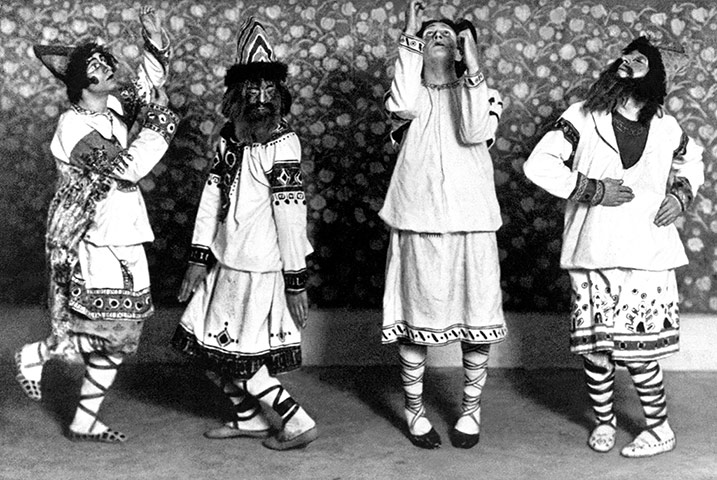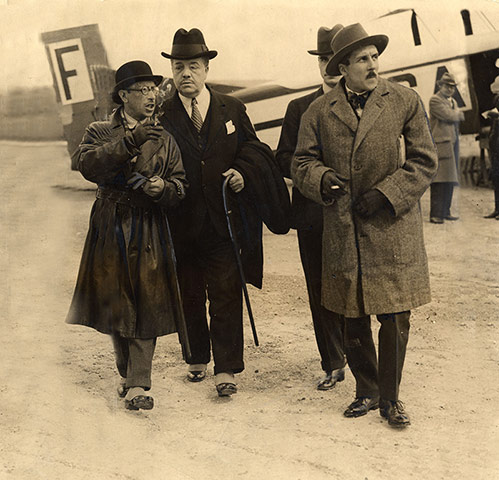
Lucky Torontonians are getting multiple opportunities to savour the 100th anniversary of Igor Stravinsky’s ballet score The Rite of Spring. We’re still more than a month away from the big day, but we’ve already heard a chamber version by Kevin Lau and Jackie Parker’s phenomenal reduction for piano solo on top of the expected symphonic outings.
- Classical Music 101: What Does A Conductor Do? - June 17, 2019
- Classical Music 101 | What Does Period Instrument Mean? - May 6, 2019
- CLASSICAL MUSIC 101 | What Does It Mean To Be In Tune? - April 23, 2019
York University Dance and Music departments add to the mix today through Saturday with Rite Redux, a performance of the full ballet score featuring new choreography by York Dance Ensemble artistic director Holly Small in collaboration with colleagues Carol Anderson, Darcey Callison and Susan Cash.
The accompaniment is a piano duo of York prof Michael Coghlan and guest John Kruspe. The show also contains other French music of the time played by pianist Christina Petrowska Quilico and flutist Kim Chow-Morris.
The shows start at 7:30 p.m. at the Sandra Faire and Ivan Fecan Theatre, at York. The box office can be found here. This is part of Sacre Celebration, a broader scholarly conference taking place during the day. You can find more details here.
We don’t celebrate anniversaries for most works of art. So why this one?
Le Sacre du Printemps is as much about a tectonic cultural shift as it is about a great piece of music or ballet.
For most people, the bassoon’s seductive opening call is the beginning of a spine-tingling journey into a piece of music that bypasses the intellect to hit one squarely in the gut, metaphorically speaking.
Put simply, this is not what music did in 1913, which is why Stravinsky’s score alarmed so many people. Vaslav Nijinsky’s choreography was the opposite of the stylized beauty and poise of classical ballet, turning a beloved tradition upside down.
Was this the birth of something awfully primitive in the gilded age of Viennese waltzes and Parisian opéra-ballets?
Were the table legs long hidden in Victorian culture suddenly going to be shockingly exposed?
What placed all of this into its proper context for me was a book published in 1989 by Toronto academic Modris Eksteins who not only bypassed academic language, but provided a brilliant cultural synthesis of the decade that peeled off the skin of the 19th century to expose the raw, glistening flesh of the 20th.
(These things don’t happen on the first dawn after a fin-de-siècle, so the story of the Rite of Spring should serve as a reminder that the 21st century’s signal cultural moment — if there can truly be one any more in a fully globe-spanning culture — may still be a few years off.)
As we zero in on the centenary of that fateful night of May 29, we need to know that Rite of Spring was as much an event as a piece of art.
First, we need to be familiar with the work itself. I recommend watching this video of a goosebump-raising performance of from the Mariisnky Theatre in St Petersburg conducted by Valery Gergiev that recreated Nijinsky’s original choreography:
+++
The people who witnessed the events leading up to and including the May 29 premiere of Le Sacre du printemps at the Théâtre des Cheamps-Élysées in Paris in 1913 are long gone. But even while each humanly unreliable narrator was alive, he or she had their own point-of-view and agenda in the retelling of those events.
We know the lore of the fights and riots, no doubt judiciously embroidered by chattering drama queens and attention seekers.
“And so where does the fiction cease and the reality begin?” asks Eksteins in his Prologue to Rites of Spring: The Great War and the Birth of the Modern Age — a book still very much in print.

It’s a very important question in this context, as Eksteins cites one of Oscar Wilde’s barbed epigrams from the dying years of the 19th century: “One should so live that one becomes a form of fiction. To be a fact is to be a failure.”
Serge Diaghilev, the founder of Les Ballets russes, the company that originated several provocative new productions in early-20th-century Paris, was as much a larger-than-life character as a genuine impresario.
Eksteins writes: “He was a Nietzschean creation, a supreme egotist out to conquer, and he succeeded in becoming the despot of a cultural empire that affected, primarily through the medium of ballet, all the arts of his time, including fashion, literature, theater, painting, interior design, and even cinema… he became central to the twentieth-century aesthetic sense, to the enshrinement of attitudes and styles rather than substance. He was the figurehead of the aesthetics of technique. People wrote long letters to him; he replied by telegram.”
It’s easy to imagine a 21st century Diaghilev as a master of Twitter in the vein of Lady Gaga or Justin Bieber.
“There is no such thing as a nonmoving object in our modern perception of life,” Diaghilev is quoted saying. That makes far more sense to us in 2013 than it did to Parisians in 1913.
Nijinsky, the dancer who broke every law of physics as he leapt across stages, was also more than a dancer. He, like Stravinsky, wanted to shock and shake-up, something that is still central to the avant-garde aesthetic today.
Eksteins writes:
Thus, from Diaghilev’s intentions to Stravinsky’s conception, Nijinsky’s aims and prediction, and [conductor Pierre] Monteux’s sense that Le Sacre would be an explosive experience, an air of anticipation, provocation, and tension surrounded the creation of the ballet. There can be no doubt that a scandale of some sort was both intended and expected. Toward the end of the year Stravinsky wrote to his mother before she went to hear her son’s latest composition for the first time in St. Petersburg: “Do not be afraid if they whistle at Le Sacre. That is in the order of things.” This was not a recognition that came to him after the fact but an intention built into the music.
Avant-garde Parisians were looking for a frisson. Youthful rebels wanted something to stick in the face of their stuffy, outmoded parents and grandparents. And the gatekeepers of Art as Beauty were on the lookout for guerilla fighters lurking behind the theatre’s fire curtain.
If these features of the ballet elicited enthusiastic appreciation from a segment of the audience, a vociferous opposition was also aroused. It demanded that art be a vision of grace, harmony, and beauty rather than an expression of idiosyncracy or neurosis; that art be morally uplifting rather than contemptuous or indifferent to prevailing mores; that the patrons of art be respected and not intentionally insulted. Stravinsky’s effort they regarded as noise, Nijinsky’s as an ugly parody. The opposition responded, as a result, in what it perceived as like manner. Insult would be met with insult, noise with noise, sarcasm with sarcasm.
Here we are, 100 years later, still very much locked into similar camps, arguments and battles. And, as strange as it may be, Stravinsky’s score still manages to alienate a lot of potential listeners.
The Rite of Spring touched a nerve — and everything it represented continues to poke and prod at our conceptions of cultures high and low, avant garde and mainstream.
One can sit and enjoy the primal relationship between senses and gut as Le Sacre unfolds. One can also wonder how it can be that a composer, a dancer and a wily entrepreneur could so aptly capture the spirit of not just one time and place, but of the whole European 20th century — one in which we still live and tweet, despite officially having flipped to a new millennium 13 years ago.
That’s why every new performance of Stravinsky’s great score, even the not so great ones, continues to have something new to say.
John Terauds
- Classical Music 101: What Does A Conductor Do? - June 17, 2019
- Classical Music 101 | What Does Period Instrument Mean? - May 6, 2019
- CLASSICAL MUSIC 101 | What Does It Mean To Be In Tune? - April 23, 2019



